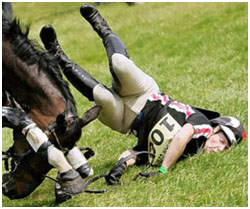Equestrian

It was once asked:
Are horses meant to have metal in their mouths, or be saddled and forced to carry us? Should they be used for entertainment?
We think not, but realise that many horse ‘owners’ (and people in general) have for so long assumed ownership over partnership (due to the pre-existing speciesist frameworks) that the ethics and science on such matters need promoting (big time) in order to overcome the big money games of Equestrian Sports. While we do not agree with everything in the selected documentaries we feel they go some way in addressing the science, ethics and method of related issues.
Most people regard horse racing as a harmless sport in which the animals are willing participants who thoroughly enjoy the thrill. The truth is that behind the scenes lies a story of immense suffering:
The Dark Side of Horse Racing
Caitlin Forrest, 19, died overnight in an Adelaide hospital following a horror four horse fall in a race at Murray Bridge in South Australia yesterday.
Thoroughbred Racing South Australia chief executive Jim Watters was quoted soon after Forrest’s death saying:
Racing is one of those sports where there are dangers […] early indications are it was just a tragic accident.
Former jockey John Letts, commenting after Forrest’s death and that of other Australian jockeys, added:
[…] we just can’t stop it, it’s something that’s just going to happen.
http://theconversation.com/we-need-to-prevent-further-jockey-deaths-in-horse-racing-34003
http://www.horsedeathwatch.com/background.php
Animal Aid’s extensive research over many years demonstrates that the industry treats thoroughbreds as mere reproducible commodities. It kills or dumps thousands every year when they fail to make the grade or when their racing days are over.
Dangerous sport that takes many casualties – US >>>1950 & 1987 100 Jockeys died – while in 2006 600 horses killed in horse races (and on average 1.5 horses die per 1000 starts).
Animals making history together with the people. The animals are endless inspiration for the human’s invention and the technology. (Stevan)
The story of Sally Garderner is an important example of how animals have played a crucial role in the advancement of technology. Muybridge had a pre-existing interest, fascination with animal locomotion, movement etc. Springfield’s vested theory seems to have motivated Muybridge who went on to apply his skills knowledge and innovation as to advance photography into motion pictures and projection; how to manipulate still images to effect movement and how to project / display this effect.
Also consider the history of flight. Our first flight attempts were born out of animal locomotion.
There is no way that we’d have developed aviation technology without envy for the majestical creatures of flight, many of our first attempts were based on flapping our arms with some make shift material for wings. Man was much heavier than his wings so flight / aerodynamics developed from there.
But they are not share equal tribute. Brutal and sad destiny of the racing horses, because the profit and fame. (Stevan)
…the film reminds us that horse weren’t originally used for racing, the taken from the wild and used to labour etc… eventually in gambling racing, sports, food at end of cycle, never afforded any real appreciation… which is of course remains true… only need to look at the horse meat scandal…
Betting on horses was once illegal. I can imagine why, how many lives gambling has wrecked? If betting on animals, horse and dog racing were illegal, there would be a lot less social problems. Do you know how much money is taken by the bookmakers? They always win.
Ingratitude for the horse champions. Senselessly money greed. Betting fun. (Stevan)
Kentucky Derby 112 times… Fendenan did not live to see a peaceful retirement. But ended up like 9,000 ex-race horses each year ‘under the butchers knife’.
Symbol of proud house with its head high, just above that two axes, slaughterhouse.
On May 27, 1995, Chris’s horse Buck refused a jump over the third fence. Buck started to jump but then stopped. Reeve held on and the bridle, bit and reins were pulled over the horse and tied his hands together. Chris landed headfirst on the other side of the fence

He sustained a cervical spine injury, leaving in paralyzed from the neck down. The impact of his body hitting the ground shattered his first and second vertebrae. (His helmet prevented any brain damage.)
After rehab, he had continuing frustration with the pace of stem cell research. He went to Israel where he tried to get the necessary cells and began his public activism after that.
Chris suffered from asthma and allergies since childhood and in 2002 and 2004 fought off a number of serious infections, believed to have originated from a bone marrow condition.
In October 2004 he was being treated for an infected pressure ulcer, which was causing sepsis, which can lead to organ failure..
The good news is that he is moving again. He has some motion in the fingers of both hands, and when he’s lying flat, with his leg bent at 90 degrees, and a helper applying her full body weight against his foot, he can push his leg straight again. With electricity pulsing through his legs – via electrodes placed on his quadriceps and hamstrings – his muscles can be made to contract and he can, in effect, pedal 10 miles on an exercise bike in an hour. Just as important, though, if less visible, is the partial sense of touch he has recovered in about 65% of his body. He can feel the prick of a needle, and the difference between hot and cold. He describes much of it in a new book of short essays, entitled Nothing Is Impossible.
“Of course, motor recovery is more dramatic, because you can see it happen,” he says. “But sensory recovery… to feel touch, after years of going without it, is very meaningful. It makes a huge difference. It means I can feel my kids’ touch. It makes all the difference in the world.”
None of this was supposed to happen. In May 1995, Reeve was taking part in a cross-country equestrian event when his thoroughbred horse, Buck, halted abruptly before a jump – scared, perhaps, by a rabbit, Reeve has speculated – and pitched his rider head-first to the ground. Reeve’s hands were tangled in the reins, so he was powerless to break his fall, and his skull literally became separated from his spinal cord. In intensive care, on a respirator, after the spinal cord had been reattached, he mouthed to Dana: “Maybe we should let me go.”
The reattachment was itself a milestone in surgical history, but his doctors were still more astonished when, in 2000, he began to feel the first twitches of motor recovery. “The conventional wisdom is that with an injury as serious as mine, you don’t recover later than one year after,” Reeve says. He remembers being in New Orleans, at a cocktail reception for a symposium of neuroscientists, two years ago, when his doctor, John MacDonald of Washington University, approached with a colleague to ask how he was. “Well, eventually they always come around to the same question: “Is there anything new?’ And I said, ‘Let me show you something.’ And I moved my left index finger on command. I said, ‘Move’ – so that they would know it wasn’t just happening randomly – and the finger moved. I don’t think Dr MacDonald would have been more surprised if I had just walked on water.” New tests show that the time between him thinking about moving his finger and the motion being accomplished is as short as in an unparalysed person.
Reeve bought a 12-year-old American thoroughbred horse named Eastern Express, nicknamed “Buck,” while filming Village of the Damned. He trained with Buck in 1994, and planned to do Training Level events in 1995 and move up to Preliminary in 1996. Though Reeve had originally signed up to compete at an event in Vermont, his coach invited him to go to the Commonwealth Dressage and Combined Training Association finals at the Commonwealth Park equestrian center in Culpeper, Virginia. Reeve finished at fourth place out of 27 in the dressage, before walking his cross-country course. He was concerned about jumps 16 and 17, but paid little attention to the third jump, which was a routine three-foot-three fence shaped like the letter ‘W’.[56]
Within weeks of his accident he was starting the advocacy work that would lead to the Christopher Reeve Paralysis Foundation and the Reeve-Irvine research centre at the University of California. Yet despite his long history of supporting liberal political causes before his accident, the obstacles to his campaign still came as a shock. “I know of one scientist who in 1996 was working, with rats, developing a drug that would cause regeneration in the central nervous system,” he says. “And the human trials were only delayed because of lawsuits brought against him by a small pharmaceutical company that had funded some of his early work and wanted a bigger piece of the pie now that he was about to work on humans. This is simply profiteering.”


Thanks for sharing. I read many of your blog posts, cool, your blog is very good.
Thank you for your sharing. I am worried that I lack creative ideas. It is your article that makes me full of hope. Thank you. But, I have a question, can you help me?